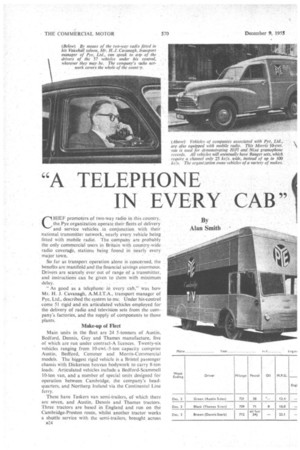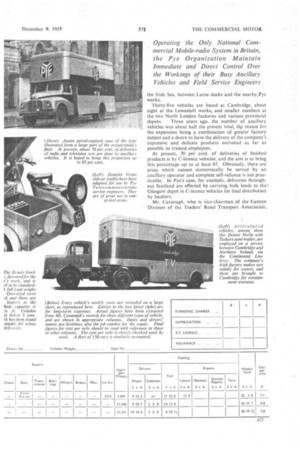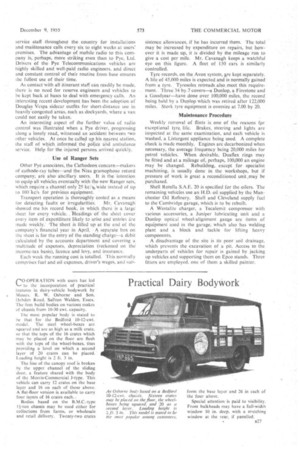"A TELEPHONE "A TELEPHONE IN EVERY CAB" I
Page 58

Page 59

Page 60

Page 61

If you've noticed an error in this article please click here to report it so we can fix it.
CHIEF promoters of two-way radio in this country, the.Pye organization operate their fleets of .delivery and service vehicles in conjunction with their national, transmitter network, nearly every .vehicle being fitted with mobile radio. The co.mpaily are .probably the only commercial users in Britain with country-wide radio coveraie, stations being found in nearly every major town.
So far as transport operation alone is concerned, the benefits are manifold and the financial savings enormous. Drivers are scarcely .ever out of range of a transmitter, and instructions can be given to them with minimum delay. •
"As good as a telephone in -every -cab,"was how Mr. H. J. Cavanagh, A.M.LT.A., transport manager of Pye, Ltd., described the system to me. Under his control come 51 rigid and six articulated vehicles employed for the delivery of radio and .television sets from the company's factories, and the supply of components to those plants.
Make-up of Fleet Main units in the fleet are 24 5-tonners of Austin, Bedford, Dennis, Guy and Thames manufacture, five of which are run under contract-A licences. Twenty-six vehicles ranging from 10-cwt.-3-ton capacity comprise Austin, Bedford, Commer and Morris-Commercial models. The biggest rigid vehicle is a Bristol passenger chassis with Dickerson boxvan bodywork to carry 8-ton loads: Articulated vehicles include a Bedford,Scammell 10-ton van, and a number of special units designed for operation between Cambridge, the company's headquarters, and Northern Ireland via the Continental Line ferry.
These have Taskers van semi-trailers, of which there are seven, and Austin, Dennis and Thames tractors. Three tractors are based in England and run on the Cambridge-Preston route, whilst another tractor works a shuttle service with the semi-trailers, brought across B24 the Irish Sea, between Lame docks and the nearby,Pye works.
Thirty-five vehicles are based at Cambridge, about eight at the Lowestoft works, and smaller. numbers at the two North London. factories and various provincial depots. Three years ago, the number . of _ancillary vehicles was about half the present total; thke reason for the expansion being a combination of greater factory output and a desire to have the delivery of the company's_ expensive and delicate products entrusted as far as possible to trained_ employees, At present, 79 per cent. of deliveries of .finished products is by C-licence vehicles, and the aim is to bring this percentage up to at least 85. Obviously, there are areas which cannot economically he served by an ancillary operator and complete self-reliance is not practicable. In Pye's case, for example, deliveries throughout Scotland are effected by carrying bulk loads to the' Glasgow depot in C-licence vehicles for final distribution by hauliers.
Mr. Cavanagh, who is vice-chairman of the Eastern Division of the Traders' Road Transport AssociatiOn, has to contend with peaks and valleys in the flow of traffic occasioned by seasonal and other influences on public demand. There is a rush in full swing now while Pye dealers are stocking up for Christmas, a peak which has come soon after one struck before the Autumn Budget.
At the crest of a peak, 60 loads may be taken in a week from the Cambridge factory on ancillary and hired transport, whilst the figure may be a little more than half this in a slack period—a surprising degree of flue , tuation. Factory output, however, stays fairly constant; sets for dispatch are drawn from stock.
Each factory produces one or more kinds of set which are not made elsewhere, and all the administration con cerning distribution is centred at Cambridge. Sales orders are given to the dispatch department and individual vehicle-loads are made up so that the minimum amount of mileage is involved for a delivery run. Factories are then notified of the make-up of the loads to be sent out by the available pools of transport. Most sets are delivered direct to dealers from the factory, except when a movement through a depot has to be arranged. As far as possible, individual drivers are directed to delivery work in those areas with which they are most familiar.
The Dennis Stork is highly favoured for the company's delivery work. At present there are six in the fleet, but this model has been adopted as the standard type and more will be purchased. A valued feature is the wide cab with flat floor which allows the driver to alight from the near side without difficulty. These vehicles have 1,000-cu.-ft. bodies of pantechnicon type, the framing being timber and the panelling of light alldy or Plymax. Dennis built seam of the bodies and Messrs. Creasey, of Knebworth, con structed others. Unladen weight is below 3 tons. Roller shutters are preferred to doors at the rear. Smith's heaters are fitted in the cabs.
Units of Capacity Load capacity is worked out on the number of units which may be placed in a van. The size of this unit is that of the case in which a table-model television set is contained, this product being handled in greater volume than any other. The load for a Stork is spoken of as 160 units.. .A radiogram may equal four units, whilst two or three table radios may represent one.
A Stork's full payload weighs up to 3 tons and the value might be several thousands of pounds, withoUt considering purchase tax. Cased sets are stacked on top of each other inside the vehicle, and stay bars are placed across at intervals to prevent the load shifting, as is normal practice with. such vehicles.
Delivery work of this kind involves diminishing loads and it is in relation to the varying amounts of space available in a vehicle for return consignments that radio control has proved invaluable. Most return loads com prise components and materials for the factories and Sets for repair. Normally, every driver is given a list B26 of the goods he has to pick up on his journey, as well as his ordinary loading sheet, but occasions do arise when diversions have to be made at short notice.
With radio control, time and empty running are saved, and management over the distribution system is as effective and immediate as it is within the confines of the factory itself. Like other company executives (and travelling representatives) Mr. Cavanagh has a mobile radio set in his own Vauxhall car, so that he can be contacted whenever he travels away from Cambridge on business.
Components and materials for the Irish, London and Lowestoft factories are supplied largely from Cambridge. Five semi-trailer loads of materials are sent each week from Cambridge to Preston, for Larne, representing about 70 per cent. of the Irish factory's needs. These semi-trailers, which are of the boxvari type, are referred to as "containers "and travel complete across the water and back again.
Greater Choice of Ships Their return loads of finished sets are mainly for export. Belfast shipping has not been found fully satisfactory, and it is preferable to be able to dispatch sets from Cambridge, from which base any of the English ports can be used, with an accordingly greater choice of ships to various destinations.
The Bristol 8-tonner runs regularly between Lowestoft and Cambridge, and the Bedford-Scammell between London and Cambridge. Most vehicles cover about 3,000 miles. a month, slightly higher distances being returned by the London-Preston tractors.
Pye Telecommunications, Ltd., makers of v.h.f. mobile radio, have a number of vehicles and, as may be expected, also provide an example of the value of radio control. Their factory is on the outskirts of Cambridge and there are subsidiary works in the vicinity. Three Vanguard estate ears perform inter-factory duties and two Austin 25cwt. vans are used to collect and deliver equipment. A Bedford 30-cwt. and an Austin 25-cwt._ van are equipped for surveys. and .demonstrations, each having an in-built generator for independent power supply. Twelve more Vanguards are based at provincial branches for survey, demonstration and installation work.
The remainder of the Pye Telecommunications fleet comprises 25 Bedford and Thames light vans used by service staff • throughout the country for installations and rnaifitenance calls every six to eight weeks at users! premises. The advantage of mobile radio to this company is,: perhaps, more striking even than to Pye, Ltd. Drivers of the Pye Telecommunications vehicles are highly skilled and well-paid radio engineers, and direct and constant control of their routine from base ensures the fullest use of their tirne.
As contact-with all itinerant staff can readily be made, there is no need for reserve engineers, and vehicles to be kept back at bases to deaf with emergency calls. An interesting recent development has been the•adoption of Douglas Vespa sidecar outfits for short-distance use in heavily congested areas, such as dockyards, where a van could not easily be taken.
An interesting aspect of the further value, of radio control Was illustrated when a Pye driver, progressing along a lonely road, witnessed an accident between tWo other vehicles. At once he 'called up.his nearest station, the staff of which informed, the police arid ambulance service. 'Help for the injured persons: arrived -quickly.
Use of Ranger. Sets Other Pye associates, the cathodeori concern7–makers of cathode-ray tubes—and the. Nixa gramophOne record company; ate also -ancillary.users. It is the intention to equip all vehicles eventually with the new Ranger sets, which require a channel only 25-kels, wide instead of up to 1001c/s. for previous equipment. •
Transport operation is thoroughly costed as a means
for detecting faults or irregularities. Mr. Cavanagh' showed me his record book, in which.. there is a large sheet for every vehicle. :Readings:of the sheet cover every item .of experfditure. likely to arise and entries are made weekly.' The "sheet s filled up at the end of the company's financial year in April. A separate box on the sheet is for the entry of the standing charge—a debit calculated by the accounts department and covering a multitude of expenses, depreciation (reckoned on the income-tax basis), licence and levy, and insurance.
Each week the running cost is totalled. This normally comprises fuel and oil expenses, driver's wages, and sub
sistence allowances, if he has incurred them. The total may be increased by expenditure on repairs, but however it is made up, it is divided by the mileage run to give a cost per mile. Mr. Cavanagh keeps a watchful eye on this figure. A fleet of 150 cars is similarly Controlled.
Tyre records, on the Avon system, are kept separately. A life of 45,000 miles is expected and is normally gained from a tyre., Tyresoles retreads.alwerneet this requirement. Three 34by-7 crzivers—a Dunlop, a Firestone and a Goodyear—have done over 100,000 miles, the record being held by a Dunlop which was retired after 122,000 miles. Stork tyre equipment is oversize at 7.00 by 20.
Maintenance Procedure Weekly removal of flints is. one of the reasons fpr exceptional tyre, life. Brakes, steering and lights are inspected at the same examination, and each vehicle is washed, a Listergent appliance being used. A complete check is made monthly. Engines are decarbonized when necessary, the average frequency being 20,000 miles for petrol vehicles.. When desirable, Duafiex rings may be fitted and at a mileage of, perhaps, 100,000 an engine may be changed. Rebuilding,, except for specialist machining, is usually done in the. workshops, but if pressure of work is great a reconditioned unit,may be purchased, Shell Rotella S.. E. 20 is'sPecified for the oilers. The remaining vehicles use an H.D. oil supplied by the Manchester Oil Refinery. Shell and Cleveland supply fuel to the-Cambridge garage, which is to be rebuilt.
A Westalite charger, a Tecalemit compressor with various accessories, a Juniper lubricating unit and a Dunlop optical wheel-alignment gauge are items of equipment used in the garage,. which also has welding plant and a block and tackle for lifting heavy components.
A disadvantage of the site is its poor soil drainage, which prevents the excavation of a pit. Access to the underparts of vehicles for repair is gained by jacking up vehicles and supporting them on Epco stands. Three fitters are employed, one of them a skilled painter.




















































































































